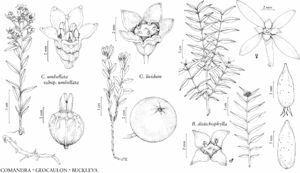Comandra
Gen. N. Amer. Pl. 1: 157. 1818.
| Taxon | Illustrator ⠉ | |
|---|---|---|
 | Buckleya distichophylla Geocaulon lividum Comandra umbellata subsp. umbellata | Yevonn Wilson-Ramsey Yevonn Wilson-Ramsey Yevonn Wilson-Ramsey |
Herbs or subshrubs, perennial, synoecious. Rhizomes somewhat woody, white to beige or blue (then drying blackish), cortex corky or papery, loose exfoliating. Leaves: petiole short or absent. Inflorescences terminal, paniclelike or corymblike thyrses; cymules 3–5-flowered; prophyllar bracteole subtending each flower persistent. Pedicels present. Flowers bisexual, campanulate; hypanthium adnate to ovary proximally, free distally, funnel-shaped; petals (4–) 5 (–7), white, yellowing with age, ovate or oblong to lanceolate, reflexed upon maturation; nectary lining hypanthium, lobes small, alternating with filaments; styles filiform; stigmas capitate. Pseudodrupes usually multiple, petals persistent, forming neck at apex; exocarp leathery.
Distribution
North America, n Mexico, s Europe (Balkan peninsula), temperate regions
Discussion
Species 1.
Circumscription of species within Comandra has varied, as have opinions about whether Geocaulon is distinct. C. L. Hitchcock and A. Cronquist (1973) considered Geocaulon as a species of Comandra, whereas M. L. Fernald (1950) recognized separate genera. The treatment here follows the most comprehensive study of Comandra to date (M. A. Piehl 1965), which recognized a single variable species with four subspecies.